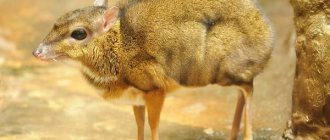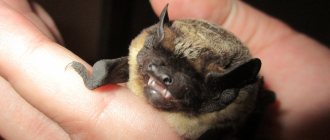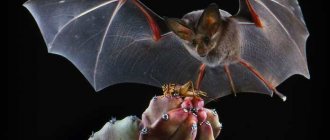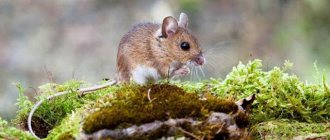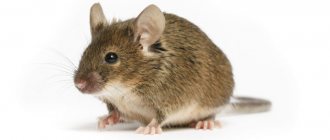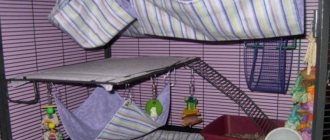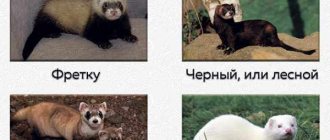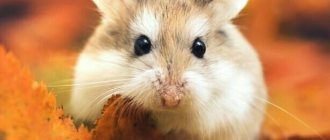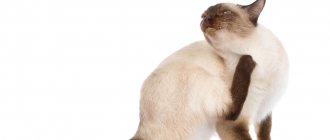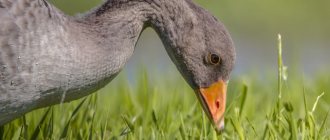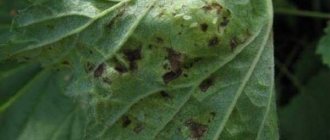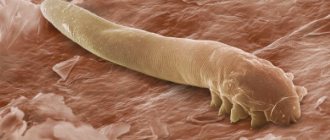For some, the small gray animal causes disgust, for others it causes tenderness. But whether a person wants it or not, the mouse is his constant companion. So why not get to know this animal better? How long do mice live? How do they triple their homes? What do they eat and how do they reproduce? How to choose a pet and provide it with comfortable conditions?
- Class: Mammals;
- Order: Rodents;
- Suborder: Mouse-like;
- Family: Mice;
- Subfamily: Mouse.
Mouse - description and external characteristics
These small rodents are distributed throughout the entire earth, excluding the extreme northern and high-mountain regions. The closest relatives of mice are jerboas, mole rats, hamsters and dormice. And more distantly related are rats, chinchillas, porcupines, beavers, and guinea pigs. In total, the Mouse subfamily includes 121 genera and more than 300 species.
The mouse is a small animal with an elongated and pointed muzzle, large round ears and bulging beady eyes. A long, hairless or slightly furred tail is a distinctive feature of the animal. The limbs, which are not the same in length, are adapted for digging and moving along vertical and horizontal surfaces. The body length of a rodent can vary from 3 to 20 cm, weight - from 15 to 50 g.
Mice have a special bite. On the lower and upper jaws the animal has 2 chisel-shaped teeth, which are continuously growing. Rodents are forced to constantly grind them down, which is why their incisors are very sharp.
Animals from the Mouse family have good eyesight and can distinguish between red and yellow shades. The usual body temperature of these rodents ranges from 37.5 to 39⁰C. The maximum lifespan of mice is 4 years.
How mice behave in their natural environment
In order for rodents to maintain a constant body temperature, they need to be active in winter and summer, day and night. Gluttony and fussiness for mice are characteristic traits that help them survive and leave offspring.
In the fall, animals begin collecting provisions in a burrow or on the surface of the ground, where the “warehouse” is camouflaged with earth. And if in the off-season rodents are awake at night and sleep during the day, then in winter they remain active around the clock. In spring and autumn, when there is no shortage of food and no temperature fluctuations, mice actively reproduce.
Mice live in large families, since together it is easier for them to defend themselves, get food, build homes, and raise offspring. In a mouse pack there is a leader who maintains order in the group. Female mice are peaceful. But young males do not always put up with their subordinate position. Stomping with its hind legs and aggressive tail strikes indicate the animal’s intention to conquer the “throne.” Inter-family clashes can lead to the disintegration of the pack.
Lifestyle
In the wild, house mice become more active at night. During the day they hide in holes for several reasons - they do not like bright light, they are afraid of predators. Housing is designed to suit people's lifestyles. They crawl out of the shelter in complete silence.
If there is constant artificial lighting in the house, house mice are active around the clock with regular breaks. There are about 20 periods of wakefulness per day with an average duration of 30 minutes. House mice move along studied routes. They leave behind feces, urine, and food crumbs.
House mice run well and quickly respond to rustling sounds and movement. The animals are capable of reaching speeds of up to 13 km/h. They climb trees and flat surfaces, jump, and behave freely in water.
Each has its own territory. The mouse does not move far from the nest; it hunts in a designated area. Males are entitled to 1200 m², females - 900 m². During the period of strong reproduction, house mice settle in families and colonies. There is a leader - a male, several dominant females.
Interesting!
The head of the family behaves aggressively towards young males; fights for primacy between females rarely occur. They raise their offspring together and take care of proper nutrition. Weak individuals try not to show themselves to the leader and begin to become active when the “leader” falls asleep. Grown-up mice are soon kicked out of the family. They create their own hierarchy.
Where do mice live in the wild?
Mice spend most of their time in burrows, raising offspring, escaping danger, storing food, or resting after eating it. The maximum depth of the burrow is 70 cm, and the total length of the passages can reach 20 m. Some species of mice build nests in thickets of tall grasses (little mouse) or live in tree roots and old stumps (forest mouse).
Minks can be temporary or permanent, and the latter can be summer or winter. Temporary housing for animals is simply planned. The permanent mouse hole has a spacious nesting chamber and several entrances. In summer burrows where rodents give birth, bedding is created from fluff, blades of grass, shavings and feathers. And in winter, a pantry is set up for food supplies.
Secluded housing
In most cases, the house mouse settles on soft soil that is not prone to drying out. To make it easier to make moves, the walls of the tunnels did not collapse. They build a hole 100 cm long. There must be an entrance and 2 emergency exits. The nest chamber is built at a distance of 30 cm from the ground surface. In winter they go deeper - up to 65 cm in depth. The diameter of the nest is about 25 cm. House mice prepare a soft bedding from twigs, leaves, moss, and all convenient materials.
Life of a House Mouse
House mice often inhabit ready-made burrows of voles, moles, hamsters, and other rodents. Or they build a nest under stones, in natural depressions in the ground, under a mound of leaves.
In human housing, house mice place their nests in well-protected, secluded places. Prefer to settle:
- under the floor;
- between walls;
- in the attic;
- under trash cans;
- in places where food waste accumulates;
- in the vegetable store.
To build a nest, various available, suitable materials are used: straw, pieces of fabric, twigs, hair, feathers, polystyrene foam, polyurethane foam.
Interesting!
The house mouse always tries to keep the nest clean. If there are parasites, the house is wet, or it just becomes uncomfortable, they abandon it without remorse and build a new nest.
What does a mouse eat in the wild?
In summer and autumn, when the time comes for the harvest to ripen, mice begin to actively prepare food reserves for winter. The main food of the animals is grain crops, as well as seeds of various plants. Field mice love wheat, barley, oats, and buckwheat.
Rodents living in forests feed on cedar and hazel nuts, maple and beech seeds, acorns, and small insects. And animals living near bodies of water prefer to eat leaves, roots and stems of plants, berries, grasshoppers, caterpillars, larvae, spiders and other invertebrates. House mice living near people willingly adapt to the human diet and eat bread, meat, dairy products, and sweets.
Animals living in the wild drink very little. The mouse body independently produces water by breaking down food. Additional sources of moisture are fleshy plant leaves, fruits, and vegetables.
Attitude towards children
They can be started in those families in which the children are 10 years old. They want to have their “own” animal, although they have no experience in caring for one. Many people are interested in the question: “Do house mice bite or not?” It is worth noting that they are not aggressive, although they can bite until they have had time to adapt to the owners and the environment, therefore, first it is necessary to help children get acquainted with the animal, as well as tame it. Very young children should not be left alone with these miniature, yet nimble and dexterous creatures.
Enemies of mice
The mouse is a key link in the food chain of many ecosystems. Many wild animals depend on the existence of this small rodent. For mice living in the forest, the main enemies are foxes, martens, arctic foxes, ferrets, stoats, weasels, lynxes and even wolves. Predators easily tear apart burrows and can eat up to 30 small animals a day.
Mice are the main food for snakes and large lizards. Reptiles such as boas, pythons, vipers, and radiant snakes swallow their prey whole. During the hunt, the snake freezes, and then suddenly attacks the victim, biting it with poisonous teeth, and then waits for the animal to become motionless.
There is also danger lurking for mice from above. Among birds there are predators that differ in the power of their beaks, visual acuity and hearing. These are owls, buzzards, hawks, eagles, owls, kites. They hunt during the day or night, making swift attacks from the air.
Mouse trap crushers
There are masher mousetraps, which are dies with a spring. The advantages of such devices are:
- significant efficiency;
- durability;
- cheapness.
They must be used carefully. There are several options for such devices
Steel mousetrap “FIT”
This mousetrap is a classic design with a wood base and a durable steel fixture. As soon as the rat wants to eat the bait, the mechanism will immediately slam shut. Such mousetraps are popular due to their low cost and trouble-free operation. The disadvantages include the fact that death does not occur instantly, but after some time. The tree gradually becomes saturated with the smell of dead rodents, and subsequently the rats will avoid old mousetraps.
Plastic mousetrap “Mr.Mouse”
This classic mousetrap is made of plastic. If we compare it with a wooden structure, it does not become dirty or saturated with odors. It can be used many times. It is safer for humans during use because the principle of operation resembles a large clothespin. The bait can be chocolate, peanuts, seeds.
Trap "House"
This trap does not kill rats, but only locks them inside. Pests cannot get out. The trap consists of a plastic pipe, which is bent at a certain angle, and two doors. After it is installed, you need to remove the back cover and put in the bait. Then place the trap in the desired place, close the back cover, and open the front door. The door is designed for a rat. When the animal crawls towards the food, it will automatically close.
How long do mice live?
The lifespan of rodents directly depends on environmental conditions. The average is 2-3 years. The greatest influence on the lifespan of animals is exerted by factors such as climate, nutrition, infectious diseases and attacks by wild animals.
Both frost and dry, hot weather can be detrimental to mice. Too sharp temperature fluctuations destroy numerous rodent colonies. Often the weather is related to the opportunity to eat well. An inadequate diet significantly shortens the life of a mouse.
Many species of mice that live away from people live a little less or more than a year. And an animal tamed by humans, receiving balanced nutrition and care, can live up to 6 years.
Reproduction in mice
The mouse is a polygamous animal. In nature, one male fertilizes from 2 to 12 females. Over 12 months, mice have from 3 to 8 litters. The female reaches sexual maturity 10 weeks after birth. At this time, she begins to go into heat, which lasts 5 days and is expressed in special behavior.
If after coating the female fails to become pregnant, a new estrus occurs within a week. If fertilization is successful, the female animal is expected to give birth in 17-24 days. There are from 3 to 9 cubs in one litter. Female mice give birth at night. Babies, when born, are unable to move, hear or see. They have no hair, and the size ranges from 2 to 3 cm. The little mice develop rapidly:
- 3 days - fluff appears on the body;
- 5 days - the cubs begin to hear;
- 7 days - the animal’s body weight doubles;
- 14 days - palpebral fissures appear;
- Day 19 - the mice begin to eat on their own;
- 25 days - the length of the body reaches 50 mm (the tail is 15-20 mm shorter) and the mouse is already sexually mature.
Decorative mice develop a little slower. It is recommended to mate them no more than 2-3 times a year. Repeated births exhaust the female, and each subsequent offspring becomes weaker.
Lifespan
Mice have many natural enemies - from the harmless hedgehog to the fox, wolf, dog, and cat. The lifespan of mice does not exceed 18 months. In captivity with proper care and an abundance of food, house mice live up to 3 years. In laboratory conditions during the experiment, the individual lived for 5 years.
On a note!
Humans not only prolong the life of rodents, but also shorten it. Using traps, electric mousetraps, cage traps, mouse poison and other control methods.
The number of rodents is subject to seasonal fluctuations. It has also been observed that the mouse population increases every 5 years. At the end of winter, the number of animals is at a minimum; with the onset of spring, rodents begin to mate. As plants grow, the number of rodents increases. There is a decline until the end of summer. The maximum number of pests is observed in autumn. At home, there are no significant fluctuations in the number of mice; the population can increase 3 times.
Types of wild mice
Shrew or shrew mouse (Myosorex)
Animals from the shrew family are divided into only 14 species. This long-nosed mouse is small in size (6-10 cm). Only the born cubs weigh less than 1 g. The animal’s nose, curved at the end, is called the proboscis. The animal's coat is shiny, thick, and silky; There are gray, ocher, reddish shades.
A mouse with a long cute nose navigates in space thanks to its sense of smell. It is an omnivore, but prefers to eat insects, as well as some vertebrates (frogs, baby rodents, small reptiles). Without food, this animal can live no more than 10 hours.
Shrews live in large concentrations in South America, Africa, and Australia. This small mouse with a long nose feels great near bodies of water, in damp forests and low-growing thickets.
Japanese mouse (Sylvaemus mystacinus)
A mouse with large round ears and a long nose. It is also called Asia Minor. Inhabits the islands of Japan, southwestern Georgia, and the Kuril Islands of Russia. Prefers mountainous uplands, mixed forests, with dense shrubby undergrowth.
Japanese mice do not dig holes, inhabiting voids in trees and buildings, accumulations of stones and dense bushes. The length of the body and tail are almost equal (up to 13 cm). They breed only during the 6 warm months of the year, during which time they produce 2-3 litters of 3-6 cubs.
Wood mouse (Sylvaemus sylvaticus)
A distinctive feature of the animal is a yellow round spot on the chest. The length of the rodent is 12 cm, the tail is 7-10 cm. These mice can occupy abandoned holes, rotten stumps, voids under stones and other natural shelters. The wood mouse is especially common in Siberia, Western Asia, Altai, and in the deciduous forests of Ukraine, Belarus, and Moldova. It feeds on cereals, seeds, nuts, and insects.
Gerbil mouse (Gerbillidae)
In the Mouse gerbil family, gerbils are classified into a separate subfamily, numbering more than 100 species of animals. The natural habitat of these animals is the arid steppes of Eastern Europe, African and Asian deserts and semi-deserts. They are active during the daytime; In winter they do not hibernate, but their lifestyle becomes more sluggish.
Externally, the gerbil mouse looks more like a rat. The length of the animal can reach 20 cm and weight 250 g. The color of the animal is brownish-sandy on the back and lighter on the chest. A well-furred long tail falls off in dangerous situations, and a new one does not grow. The gerbil mouse can walk on its hind legs and jump over long distances (up to 4 m). It feeds on grains of wheat, barley, corn, millet, as well as fruits and nuts.
Little mouse (Micromys minutus)
The name of the genus is associated with the miniature size of the animal. The maximum body length of the animal is 7 cm, and the tail is 5 cm. The animal prefers to live in the steppe and forest-steppe, in grain fields, and in floodplain meadows. Among the grass you can find spherical houses of this rodent, made of dry stems and leaves.
The baby mouse is distinguished by its fiery red coloration of its skin, which appears after the first molt. It feeds on invertebrates, green leaves, and grains. The little mouse is peaceful, quickly adapts to a new environment, and therefore can be tamed by people.
White mouse (Mus musculus)
It is also called the house mouse or house mouse because the animal has adapted to live near humans. In living quarters, sheds, and storerooms, these rodents hide complex, multi-channel burrows, where they live in large colonies. Not far from their burrows, they make storage areas for food: seeds, nuts, crackers, pieces of vegetables.
The white mouse is not a large animal, its length reaches 8-11 cm. The long tail is covered with sparse hair, and scaly rings are clearly visible on it. The color of the animal’s skin depends on the species, but the fur on the back is darker than on the belly. The house mouse lives on all continents, in all climate zones and is a faithful companion to humans.
Grass mouse (Arvicanthis)
The length of the body of an individual, including the tail, can exceed 30 cm. The gray or brown fur consists of elongated soft hairs and stiff bristles, as well as hard spiked hairs in some species. Their rhythm of life is similar to that of humans - they are awake during the day and sleep at night.
The homeland of grass mice is Southeast Africa. These rodents love moisture and live mainly in river floodplains and in humid tropical plantations. They can both dig holes and occupy other people's homes.
Field mouse (Apodemus agrarius)
The field mouse is not like other rodents of the Mouse family. The animal has a clear, contrasting color stripe on its skin, which runs along the entire spine, from the muzzle to the base of the tail. The size of the animal varies from 8 to 12 cm without a tail. The color, depending on the species, can vary from light gray to dark brown and black. The field mouse builds its home on its own or uses suitable structures.
The field mouse inhabits the territories of Western and Northern Europe, as well as part of Asia: China, Sakhalin, Taiwan. The animal loves meadows and fields, in deciduous thickets, but is also found in the city. The field mouse feeds on invertebrate insects, cereals, plant stems and fruits.
Varieties
House mice live everywhere. This is facilitated by high adaptive capacity. The animals tolerate cold and heat relatively well and adapt to any living conditions. Close proximity to humans ensures survivability - a minimum of enemies, a large amount of food. A typical representative of mice can be found outdoors and indoors. Lives in garages.
House mice are the most common experimental specimens in laboratories. Over many years of work, breeders have intentionally or unintentionally bred many different subspecies of house mice. But several have been officially identified.
House mouse classification:
- musculus – has become widespread in Poland, Northern and Eastern Europe, and parts of Russia;
- bactrianus - an interesting species of domestic mice found in Asia;
- domesticus - a heat-loving species found in Southern Europe, America, Africa, Australia;
- castaneus is another representative of Asia, only in the southeastern part.
Types of mice For a long time, there was another type of domestic mouse - Mmmolossinus. Rodents have become widespread in Japan. However, later scientists stated that this species cannot be classified as a separate type, since they obtained the animals by crossing Mmmusculus, Mmcastaneus.
House mouse: choosing a pet
Decorative mice are friendly, non-aggressive, clean, quickly get used to their owners, and are very easy to care for. When choosing an animal, you should pay attention to the habits and appearance of the rodent. An animal in good health looks like this:
- the fur does not stick out, there are no bald patches;
- teeth white, straight;
- the animal has moist and shiny eyes;
- the animal does not have mucous discharge from the nostrils and eyes;
- The mouse is actively moving and feeding.
We must not forget how many years mice live. The maximum lifespan of these animals is 3-4 years, so it is better to choose a pet under the age of 12 months. You need to pay attention to the sex of the rodent, since several males will not get along in one home.
Males are slightly larger than females, their body resembles an elongated pear. A 30-day-old male mouse has formed testicles under its tail. And in the female, from the 3rd day after birth, 5 pairs of rudimentary nipples are clearly visible.
The house mouse is a collective animal, so it is better to purchase several individuals. If further breeding of animals is planned, then males and females must be kept separately until mating.
Notes
- [https://www.rspb.org.uk/international/science/miceeatchicks.asp Metre-high seabird chicks being eaten alive by mice]
- [https://www.newizv.ru/news/?id_news=21901&date=2005-03-25 Article about the Methuselah Foundation]
- [https://www.polit.ru/news/2004/07/14/cancer_print.html Is cancer a viral disease?]
- [https://krolik-rodent.narod.ru/photoalbum6.html Varieties of lines of decorative mice]
- [https://www.medportal.ru/mednovosti/news/2002/12/05/mouse/ The mouse genome has been deciphered]
- [https://news.nbc.com.ua/NEWSactionISarticleANDidIS1245ANDdateIS4.6.2002.html Scientists reveal the secrets of memory]
Mice for keeping at home
Thanks to modern selection, ornamental mice have hundreds of species, among which there are singing, “waltzing”, and animals with unusual coat colors (white albino mice, pure black mice, ashy and cream-colored animals).
Some types of mice are especially popular:
- The Japanese dwarf mouse is very tiny, up to 5 cm long. The white skin is decorated with black and brown spots. Friendly, clean and energetic. Leads a nocturnal lifestyle. There are 5-7 mice in a litter.
- The spiny mouse or akomis is a large decorative mouse with many needles located along the entire back. The color is reddish-brown or blackish-red. The neck is framed by a voluminous fat hump. The nose is elongated, the eyes are bulging, the ears are large and oval in shape. The mouse is very active and quickly gets used to people.
- The decorative African striped mouse has an interesting coloring: light and dark stripes alternate along the body. The animal does not emit an unpleasant odor. It climbs well on vertical surfaces. The striped mouse is a very shy animal. In case of danger, it can pretend to be dead or jump to a height of up to 2.5 m. The body length rarely exceeds 10 cm.
Notes
- V.E.
Sokolov. Systematics of mammals. Orders: lagomorphs, rodents. - M.: Higher School, 1977. - P. 314-316. — 496 p. - Gromov I.M., Erbaeva M.A.
Mammals of the fauna of Russia and adjacent territories. Lagomorphs and rodents. - St. Petersburg, 1995. - P. 271-276. — 522 p. — 1000 copies. - .
- Russian names according to V. E. Sokolov.
Five-language dictionary of animal names. Mammals. Latin, Russian, English, German, French. / under the general editorship of academician. V. E. Sokolova. - M.: Rus. lang., 1984. - P. 183-184. — 10,000 copies. - ↑ Complete illustrated encyclopedia. "Mammals" Book. 2 = The New Encyclopedia of Mammals / ed. D. MacDonald. - M.: Omega, 2007. - P. 451. - 3000 copies. — ISBN 978-5-465-01346-8.
Care and maintenance of mice at home
The house where decorative mice live can be a cage, an aquarium, or a transparent plastic box. For a small number of animals, a dwelling measuring 25*45*22 cm is sufficient. The bottom of the terrarium is covered with sawdust from fruit trees or hygienic filling made from corn, paper, or straw. Decorative rodents need to change their bedding at least once a week, but preferably every 3 days. The top of the terrarium is covered with a lid with holes for oxygen.
Several shelters are equipped inside the house, preferably at different heights. All types of mice are very active and run up to 40 km a day in their natural environment, so the terrarium should have a running wheel. You can supply water to rodents through a hanging drinking bowl or pour it into a small saucer.
A decorative mouse is an animal that easily gets cold and overheats. It is better to place the animal’s house away from the window, protect the cage from drafts and bright sunlight. The ideal temperature for these rodents is 20-22⁰С.
What do decorative mice eat?
All animals from the Mouse family are prone to obesity, so you need to know what the ornamental mouse eats. The basis of the animal’s diet is cereals: barley, wheat, corn, sorghum. The grain should not be ground. Usually house mice are very small and eat up to 1 tsp per day. stern.
The animals' favorite treats are sunflower seeds, pumpkin seeds, caraway seeds, walnuts, peanuts and hazelnuts. Vegetables and fruits are necessary in the animal's diet. It is better if the vegetables are green: cauliflower, lettuce, cucumber, zucchini, broccoli, parsley. And the fruits are not very sweet and juicy: apple, banana, quince, pear, plum. Occasionally you can give bread and egg whites.
What mice don’t eat: citrus fruits, smoked meats, meat, food for cats and dogs.
Mice: benefits and harm
Species of wild rodents have long been considered enemies of humans. The field mouse damages grain crops. The house mouse contaminates food with feces and urine, and damages books, clothing, and home furnishings. Many types of mice carry infectious diseases: salmonellosis, hepatitis, encephalitis, toxoplasmosis, false tuberculosis and others.
But mice also bring significant benefits to people. Cosmetologists and doctors have been using mice for centuries to conduct all kinds of experiments. This is due to the extraordinary fertility of rodents and the similarity of the human and mouse genomes.
Zoologists raise special food mice for pythons, agamas, boas, geckos, snakes, ferrets, owls and cats. Sometimes decorative rodents are used for such purposes and sold to pet stores.
Taxonomy
In the genus Mus
There are about 45 species, grouped into 4 subgenera:
Subgenus Mus
- Indian mouse ( Mus booduga
), or small Indian mouse - Ryukyuan mouse ( Mus caroli
) - Yellow-brown mouse ( Mus cervicolor
) - Cook's mouse ( Mus cookii
) - Mus cypriacus
- Nilgiri mouse ( Mus famulus
) - Mus fragilicauda
- Macedonian mouse ( Mus macedonicus
) - House mouse ( Mus musculus
) - Algerian mouse ( Mus spretus
) - Kurganchik mouse ( Mus spicilegus
) - Bengal mouse ( Mus terricolor
) - Mus nitidulus
Subgenus Pyromys
- Sri Lankan mouse ( Mus fernandoni
) - Phillips's mouse ( Mus phillipsi
) - Spiny mouse ( Mus platythrix
), or Indian spiny mouse - Madras mouse ( Mus saxicola
) - Shortridge's mouse ( Mus shortridgei
)
Subgenus Coelomys
- Shrew mouse ( Mus crociduroides
) - Major's mouse ( Mus mayori
) - Sikkimese mouse ( Mus pahari
) - Java mouse ( Mus vulcani
)
Subgenus Nannomys
Mus musculoides
- Guinea mouse ( Mus baoulei
) - Toad mouse ( Mus bufo
) - Callewaerti's mouse ( Mus callewaerti
) - Gunda mouse ( Mus goundae
), or gound mouse - Senegal mouse ( Mus haussa
) - Pygmy desert mouse ( Mus indutus
) - Mahomet mouse ( Mus mahomet
) - Matthay's mouse ( Mus mattheyi
) - Dwarf mouse ( Mus minutoides
) - Temminck's mouse ( Mus musculoides
) - Southern pygmy mouse ( Mus neavei
) - South African mouse ( Mus orangiae
) - Central African mouse ( Mus oubanguii
) - Peter's mouse ( Mus setulosus
) - Setzer's mouse ( Mus setzeri
) - Thomas's dwarf mouse ( Mus sorella
) - Graceful mouse ( Mus tenellus
) - Grey-bellied pygmy mouse ( Mus triton
) - Kasai mouse ( Mus kasaicus
) - Mus ferox
Mice in history and culture
In ancient Greece, the white mouse was considered a sacred animal. Colonies of thousands of animals lived in the temples. They were heroes of legends and myths. They thought that the white mouse helped the oracles see the future, and the active reproduction of animals promised prosperity and a good harvest. The black mouse was considered a product of dirt and was subject to extermination.
In Japan they believed that a white mouse brings happiness. Seeing a place where a colony of rodents lives is a good sign, but a dead mouse meant grief. The Chinese considered this animal a symbol of wisdom and honesty. But among the ancient Persians and Egyptians, on the contrary, both the white and black mice were endowed with destructive, evil powers. They associated rodent invasions with the machinations of the terrible god Ahriman.
Cats appeared in the human home due to the dominance of harmful rodents. Even 6 thousand years ago, people began to feed wild cats, and they, in turn, began to protect their food supplies. But even now mice remain a favorite pastime for domestic cats. This long-standing enmity is the basis of many fairy tales, songs, cartoons, and proverbs. In the Internet era, special videos for cats have appeared. A mouse on the screen becomes a reason for a domestic cat to remember its hunting instincts.
